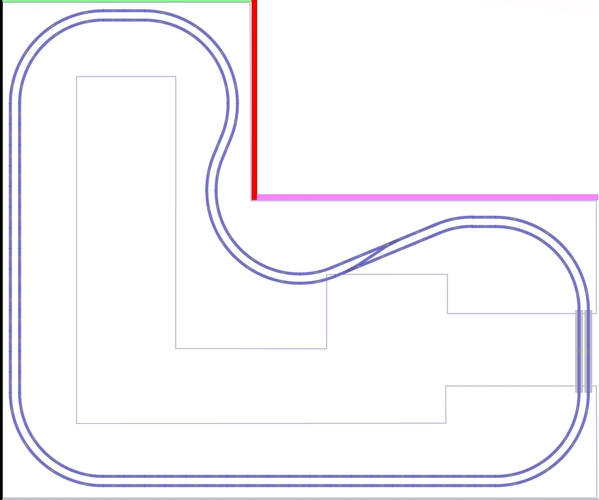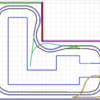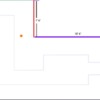Hello All, First thanks for your patience in advance as I have some limiting conceptual issues. I have read much from magazines, books and forums about planning, however even the most basic step is eluding me. My available area is an L shaped space that is 12 foot wide twenty 24 feet long with an additional 10 foot wide by 6 foot deep leg of the L. While trying to keep a 30-36" reach, planning out aisles for this shape with retaining the most layout area is obviously something beyond my comprehension. Any help, advise will be greatly appreciated.
Replies sorted oldest to newest
You didn't say if there was an opening or where it was, so I guessed it was on the right where your lines don't connect. Here are 2 ways of approaching the space. First is an around-the-room design. The second is a table with access on all sides. Obviously you get more usable track space with the around-the-room design and can use wider curves.
Attachments
First thing that you gotta do is get down on your knees and thank the Lord for granting you so much space. ![]()
Sorry for not giving entrance to area. The assumption that the right side is open, is correct. And it is totally open, giving access to both sides of the around the wall part of that section. So the open area could be wider than 3 feet. I could put access door(s) on the sides that of the inner "L" So if you were standing at the left side looking into the room, the wall to your right, the wall that makes the 90 degree right into the "L" and the next wall that makes the next left. I hope that is not too confusing. I am not sure if that will give any benefits or be a hindrance. The right side entrance to the room could be lengthened in the future, from 24' to 32'. T
And yes I am VERY Grateful for the large space, and do not want to waste any of it.
I do lean towards the around the room design and wondered about putting in some peninsulas for more layout room.
Also hoping to make a "lower" subway level that will come up to main level for a small elevated section.
Thanks for the replies, they are extremely helpful.
I don't know if I followed that, so I color-coded a few things.
And it is totally open, giving access to both sides of the around the wall part of that section. So the open area could be wider than 3 feet. Does this mean there is no Purple wall or does it just mean the small peninsulas on the right side could be 6' wide (Blue rectangles) instead of 3'?
I could put access door(s) on the sides that of the inner "L" So if you were standing at the left side looking into the room, the wall to your right, the wall that makes the 90 degree right into the "L" and the next wall that makes the next left. Does this mean you could add door access through the Red and Green walls? If so, I guess that would let you fill in the Gray area.
wondered about putting in some peninsulas for more layout room. I suppose you could add the Green peninsula.
Attachments
Thanks for helping on the clarity. The black and grey walls are foundation walls without access. The purple, red and green are accessible (they have yet to be built) There will be a purple wall built so the blue area could be 6' .
The purple, red and green walls, have at least four to twelve feet behind them for water filters and another room. This is a basement build and is right now totally open.
Thanks for the ideas!
Ok, so here's what I've come up with then, assuming I understood what you said about the purple wall. I don't think I'd add the doors just to fill in the gray area, but that's up to you. If I were to add a door, I'd add a double door on the green wall.
Attachments
Again clarity is not my strong suit. The purple wall is not moveable, it is 12' from grey wall. I like your peninsular ideas. Let me know what you think of this possibility? It is your design with purple wall fixed at 12' Let me know plus and minus of this and any improvements that will help.
Thanks for your time and help
Attachments
Ok, got it. As you can see, I left 2 small peninsulas on the ends in case you wanted to add reversing loop capabilities. The Blue tracks are Atlas with O72 curves. The Yellow tracks are Atlas with O54 curves just to show how reversing loops would fit.
Attachments
THANKS Sooooo Much! This is a great help and a fantastic start! Reversing loops were some of the hopefuls on my list of track.
Iam looking at getting RR-Track but they are not accepting orders until later this month. uess it will have to wait. Not a big deal as now it is more what industries and towns do I want to build and where they should be built. Figure out a purpose for the railroad and possibly a subway set stuck it somewhere.
The blue track that goes across the opening, will allow me to, hopefully be using my 40" atlas bridge building a lift up to pass through to the middle of the layout.
Any thoughts on control area placement?
Again HUGE Thanks
Reversing loops were some of the hopefuls on my list of track. Unfortunately, they take up a lot of space if you try to use large curves, hence the O54 curves in my example. The thing is when you have the capability to run multiple trains in different directions, the need to reverse trains is lessened, especially in around-the-room designs.
I am looking at getting RR-Track but they are not accepting orders until later this month. Guess it will have to wait. Not a big deal as now it is more what industries and towns do I want to build and where they should be built. Figure out a purpose for the railroad and possibly a subway set stuck it somewhere. Just a thought, you might take a look at SCARM and AnyRail while you're waiting on RR-Track, both have trial versions limited to 100 tracks and both are cheaper than RR-Track. I have both RR-Track and SCARM and almost exclusively use SCRAM these days. Ken-OScale posts a lot of designs done with AnyRail.
The blue track that goes across the opening, will allow me to, hopefully be using my 40" atlas bridge building a lift up to pass through to the middle of the layout. Shouldn't be any problem adding the bridge to a design.
Any thoughts on control area placement? Not really, too much depends on the design you come up with and how you decide to control things, particularly switches and accessories. If you go with a full DCS system (remote, TIU, AIU. WiFi), you can control it all from the remote and/or a tablet. If you're "old school" and prefer pushing buttons, then you might want a central control panel.
Thanks for all the help again, I will get scarm and use that if I can post layouts from scarm, is that possible?
Again Many Thanks
Okay, thought I would toss this in -
- 30" wide table - perhaps 36" on one side if a yard is needed - it is plenty for tracks and scenery
- Atlas 081 and O72 double main - crossovers, sidings to be added
- O72 reversing circle on the inside corner- will only require a smaller increase of the table on that inside corner and still maintain good aisle width
I followed what I thought were the dimensions as none are marked on the table drawings
1' grid
refinement to come with design development
Attachments
Yes, you can post files from all the design programs. Here's the SCARM file of your space to get you started. I had to delete the reversing loops to get the track count below 100 so you can play with it. You won't be able to make add many tracks, but you can add a few and learn how to move tracks around, etc. To download the file, right-click and select Save As (or Save Link As, whatever is close). Sometimes it downloads as a .txt file, but all you have to do is change the filename to end with .scarm.
That said, I'm not trying to get you to buy SCARM instead of RR-Track. SCARM was free for a long time while it was in beta, so a lot of folks took advantage of that to save some money. Since it's gone commercial, the number of new users seems to have lessened, but then so has the number of new layout designs being posted. There is a lot of helpful information, tutorials, etc., on the SCARM site and a few folks here who will help you learn how to do things. There are also folks who will help with RR-Track and AnyRail.
I started using SCARM to help others with their designs. It wasn't available until after I had already bought RR-Track. Eventually, I was using it more and more because of all the designs being posted with it, the arguably better 3D view and the 3D simulation feature. RR-Track has a simulation too, but it's only 2D. When I mentioned it I didn't know the RR-Track would be available again on the 17th, so I thought you might want to check out other options. There are advantages/disadvantages to all of them. One advantage to RR-Track is you can purchase a library with a lot of accessories, buildings, bridges, etc. SCARM is limited, but you can create your own or copy what others have shared.
Note that SCARM and RR-Track are both Windows-based. If you use a Mac, you might consider RailModeler Pro or you'd have to use a Windows emulator.
Attachments
Hi Carl, Great ideas and starting points! I have taken a bit of a crash course in scarm and have room dimensions that I will try to upload to this post. It will also contain a possible layout base around the room. The room dimensions are all fixed and per wife non negotiable. ![]() The only leeway I will have is the black wall can extend another 10' in the future.
The only leeway I will have is the black wall can extend another 10' in the future.
Hope this helps clear any dimensional lack of clarity on my part.
Attachments
Hi Dave, I have jumped on the Scarm band wagon and have been taking a crash course so to speak. Thanks for the knowledge and work you have put into my project. It is so appreciated. As you can see from my earlier post, the room dimensions and possible bench work. Not sure on bench work as it will depend on track features and uses for the railroad.
To help all explain how new I am to this, I was fortunate as a young boy to get Lionel trains for Christmas and Birthday presents. My dad would set it up on in our tiny three room apt. that housed my Mom, Dad, Sister and myself. Not a lot of room to say the least. Over the years my collection grew and then college hit and life began. Trains were put away for years, except the occasional Christmas set up. I am now newly retired, moved to a new area, Hadley Pa. (near Mercer pa. home of Mercer Junction train shop) So I am fortunate to have the time, my health, and space to build a model railroad. The last forty year gap in technology is amazing and totally unbelievable. I have a lot to learn about the new generation of trains. I have not been into railroads and how they worked in industry, and also have little knowledge of model railroad track functions. (ie reversing loops) I get how they can make a more point to point railroad which is more reality than a train running around in a circle. However, these things I am just learning. Where to put sidings? Should there be a yard? What industries will the railroad serve? Towns and destinations? I have a HUGE list of questions and probably don't know have of the questions I need to ask.
So please all bear with me as I am the true Newbie.
Thanks in Advance for all the help.
Go with the largest curves you can fit in. Here is a double mainline with O81/O90 curves. The right side restricts using larger curves. The 90 degree curves could be replaced with larger curves.
Jan
Attachments
I don't mean to nitpick, but as drawn the Green wall is 10' 6" and that will make a difference when you start adding track. The upper jut-out on the right is 4' 8", not 4' 6", and that may or may not make a difference, but I thought I'd point it out just in case.
And just for the sake of total clarity, I'm assuming the dimensions are inside measurements and the walls you're going to build will all go on the outside of this space. That may seem like a small thing, but I've seen people add basement walls that end up taking away from the actual interior size of the room. Normally that doesn't matter, but model railroad designs are a matter of inches, so losing 5"-6" to walls can be a big deal if not accounted for in advance.
NOTE: This is referring to the SCARM file Aegis posted, not Jan's file. Jan was posting as I was composing, so I didn't see his post. Fortunately, Jan used the file with a 10' wall and his choice of curves fit. ![]()
How about a reversing siding? Pictured here in green... along with a double mainline and a double crossover...
Attachments
DoubleDAZ posted:I don't mean to nitpick, but as drawn the Green wall is 10' 6" and that will make a difference when you start adding track. The upper jut-out on the right is 4' 8", not 4' 6", and that may or may not make a difference, but I thought I'd point it out just in case.
And just for the sake of total clarity, I'm assuming the dimensions are inside measurements and the walls you're going to build will all go on the outside of this space. That may seem like a small thing, but I've seen people add basement walls that end up taking away from the actual interior size of the room. Normally that doesn't matter, but model railroad designs are a matter of inches, so losing 5"-6" to walls can be a big deal if not accounted for in advance.
Hi Dave, nitpick and find all mistakes etc. The details are EXTREMELY important and an inch here or there does/can make huge differences. You are correct he green wall 10'6" dimension the marked 4'6" is adjustable to aisle width and is drawn as 4'8" (I was playing with track and nudged that a bit without changing the label.
You are also correct with the wall dimensions being interior. The basement is 27' wide with supporting columns at the center. This actually allows me to build the purple wall 12'6" interior dimension from black wall. I was being cautious with initial dimensions, so 12' is actually 12'6"
Now this is before the walls are built however I have the leeway to make those dimensions when I build.
Now the bad news. I originally thought the leg of the L was to be 8' by 8' and supporting column was covered. Now that I convinced my wife to give 2.5' it will no longer be covered and is represented by the orange circle... ugh!
Here is an updated, more precise drawing.










